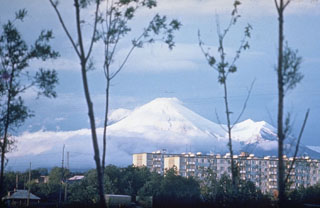Report on Avachinsky (Russia) — January 1994
Bulletin of the Global Volcanism Network, vol. 19, no. 1 (January 1994)
Managing Editor: Richard Wunderman.
Avachinsky (Russia) Fumarolic activity from central crater
Please cite this report as:
Global Volcanism Program, 1994. Report on Avachinsky (Russia) (Wunderman, R., ed.). Bulletin of the Global Volcanism Network, 19:1. Smithsonian Institution. https://doi.org/10.5479/si.GVP.BGVN199401-300100
Avachinsky
Russia
53.256°N, 158.836°E; summit elev. 2717 m
All times are local (unless otherwise noted)
Seismicity was at background levels from mid-December into early January. During 4-6 January, a slight increase in seismic activity (16 events) was recorded at the volcano, but seismicity had returned to background levels (2-3 events/day) by mid-month. Seismicity was again above background in late January through mid-February. Strong fumarolic activity continued from the summit lava flow in the central crater. Similar activity was noted in May 1992, and in April, August, September, and October 1993.
Geological Summary. Avachinsky, one of Kamchatka's most active volcanoes, rises above Petropavlovsk, Kamchatka's largest city. It began to form during the middle or late Pleistocene, and is flanked to the SE by Kozelsky volcano, which has a large crater breached to the NE. A large collapse scarp open to the SW was created when a major debris avalanche about 30,000-40,000 years ago buried an area of about 500 km2 to the south, underlying the city of Petropavlovsk. Reconstruction of the volcano took place in two stages, the first of which began about 18,000 years before present (BP), and the second 7,000 years BP. Most eruptions have been explosive, with pyroclastic flows and hot lahars being directed primarily to the SW by the collapse scarp, although there have also been relatively short lava flows. The frequent historical eruptions have been similar in style and magnitude to previous Holocene eruptions.
Information Contacts: V. Kirianov, IVGG.

